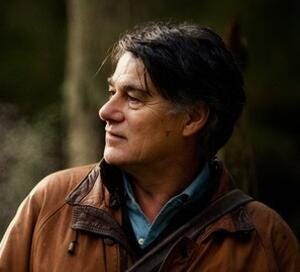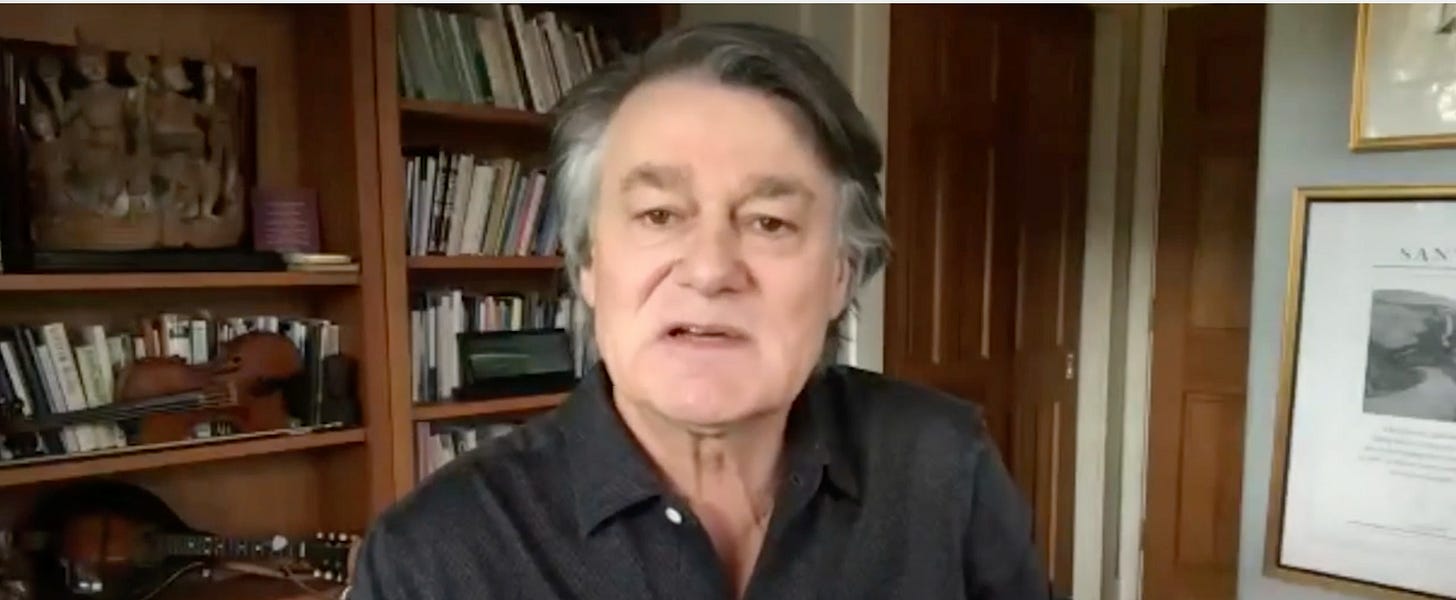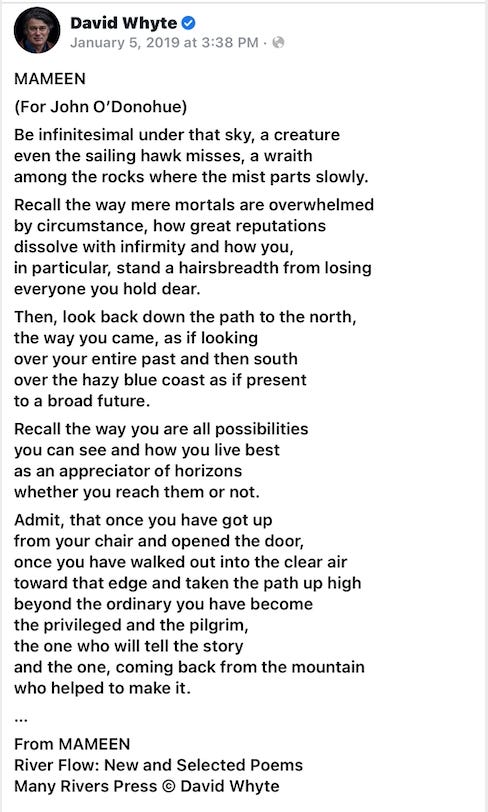Poet, David Whyte at the Cliff's Edge
As we stand at the edge of Easter and the edge of all kinds of new beginnings, I don’t want to go back to the way things were. I want to go forward into a new world with new promise.
“The waves and the energy of the sea meeting the land and the mountains beyond generate a very palpable experience of being drawn out of ourselves just by the sheer physical power of the place. Felt fully, there is the sense of a wild frontier or edge meeting some interior equivalent or symmetry. It’s almost as if there is an internal shoreline which meets this external shoreline – an edge that can be replete with energy, creativity and a certain kind of wild, untrammeled joy. “
- David Whyte, from At the Edge of the World
Have you ever stood on the edge of a cliff? Take a minute and imagine that feeling. Like the above quote says, there’s an energy at the edge of a cliff, a dangerous pull to fly. Or perhaps you imagine the vision of the landscape and the gift of expanse the cliff allows. Either way, the energy is palpable. I feel it right in my solar plexus.
I’ve been dreaming of cliff edges lately.
The most vivid of these dreams was the most terrifying I’d ever had. I woke up gripping my covers, heart racing, stomach and neck tight from straining to scream. (Perhaps, just perhaps, there’s some repressed anxiety of the last year. *eye roll*)
It felt like more than that though. It felt mythic.
Excerpt from THOOR ANU
You did not know you had come
to meet the ocean,
thinking the cliff edge
had everything you'd need,
but when you stared into
the deep vault
of blue from which the revelation
came
and you heard the drumbeat
of arriving water
and looked into
the bowl
of waves and breaking foam,
and sat there stunned
and numb in the underbelly
of the turning world
the vision
was immediate,
a ghost-like far-in horizon
come to meet the sea [...]
Since the night I woke up from the nightmare on the cliff’s edge, I’ve been trying to put some meaning around it. Howard Thurman gives us “the growing edge” of hope; Richard Rohr gives us the phrase “on the edge of the inside” referring to intentionally staying on the margins of places; and the poet David Whyte gives us poetry “At the Edge of the World.”
This is the title of a three part Sunday series that Whyte is currently hosting. It has been like sitting by the turf fire having tea with your favorite professor, who you have a massive crush on, as you sit dreamily hanging on his every word. Sometimes he even has cool musicians over to play Irish music. That’s my perspective. He describes the series as a “mythopoetic tour of the West of Ireland.” Ok, it’s that too.
Bill and I were planning a trip to Ireland last summer before Covid hit. In preparation I had just done a big project on the poet and theologian John O’Donohue for a class’ final paper. I had lived in the landscape of Ireland in my imagination for months reading O’Donohue as I imagined walking with him in The Burren. Whyte and O’Donohue were close friends and shared the same vision of the poetics of place. For both poets, one a former priest and the other a Zen Buddhist, the landscape of Ireland is woven with the ghosts of ancestors and the thresholds of thin places.
One such place, Whyte says, where the mountains meet the sea is a place of “ancient conversation” where the interior landscape meets what’s beckoning outside. It is a threshold mythic in scope. “This wild edge for which we all have an interior equivalent symmetry,” as Whyte describes is, I believe, that place that sent me reeling in my dream. Why was I so afraid?
The edge is always an invitation to go deeper. To drink from a deeper well.
So how do we do that, preferably without waking up to your own silent scream? I’m going to attempt to answer based on what I’ve learned so far sitting at the feet of the poet.

Step 1: Be good to yourself and stop the conversation that you’ve been having with yourself for so long. What would happen if you just stopped telling yourself the stories? You don’t need to justify, disprove, reimagine - just stop. There in the silence beneath the stories, what’s left? Who are you? At this edge of time and expanse of future, this is a good place to let go our unhelpful stories
But for now you are alone with the transfiguration
and ask no healing for your own
but look down as if looking through time,
as if through a rent veil from the other
side of the question you’ve refused to ask.And you remember now, that clear stream of generosity from which you drank, how as a child your arms could rise and your palms
turn out to bless the world.(from TOBAR PHADRAIC)
Step Two: Embrace our aloneness, even as we are connected to all things. This relationship between aloneness and connection is in constant conversation, perhaps even negotiation. I think of a young mother who as everyone is pulling at her body, her time, her resources she can be in a state of utter aloneness. (If you are on insight timer there is a beautiful new course from Sarah Blondin called This Deepest Self that starts with a guided mediation on The Wisdom of Loneliness where she describes “the jagged edge of loneliness.”)
We have all experienced loneliness in this last year, but have we also gained a capacity for aloneness that we can bring forward? To embrace our solitary nature is to embrace our essence which is connected to everything. Counterintuitive for sure. Standing back at the edge of our aloneness we’re able to see everything we are connected to.
Step Three: Risk yourself at the edge. So often to avoid the loneliness of isolation or the overwhelm of connection, we stay safely and numbly in the center of all things. There’s an exercise I do every year with my students. I ask them to walk around the stage. Simple. Just walk. I don’t give them any more direction than that, and yet every year they all do the same thing. They walk at a middling speed in a circle. Like sheep. Or zombies. Or zombie sheep. After prompting them with instructions, they begin to walk at different speeds, in different directions. They start to make shapes with their bodies, and walk with big or small steps. Sometimes they even stop. And when they begin to realize all the choices at their disposal, they begin to find joy. We humans avoid giving ourselves the inheritance of our own agency. Especially when it comes to a simple act, we can overlook the joy it offers.
Whyte also reminds us of the French philosopher Camus who writes, “Live to the point of tears.” When we move away from the middle numbness and take this risk of joy and tears, we remember the younger parts of ourselves where joy and tears were common occurrences each day. The world meets us at this edge with a clear stream of generosity. But trusting that this sheer grace is available to us in that place of vulnerability is not an easy step to take towards that cliff edge. (cue silent screaming)
Step Four: Practice radical acts of generosity. Once you experience that stream of generosity you can then become that stream. Put down your phone. Get outside and make space for conversation perhaps with a younger person that needs to be seen and heard. Practice generosity with yourself and rest. As Whyte says, “touch that bedrock of rest — the ability to breathe deeply.” We have all been through so much and as we look towards a new day, let it be filled with graciousness.
“When you find a place in Nature where the mind and heart find rest, then you have discovered a sanctuary for your soul.” - John O’Donohue
So why was my dream at the Cliff’s Edge so desperately frightening? I have an idea. Whyte uses a metaphor about poetry that I’ve often used when teaching acting. That in order to be creative - authentically, truly creative - you must jump. It is a terrifying step of vulnerability to trust your work, trust those around you.. trust that the stream of generosity will be there for you if you fall. We cannot horde control and be an artist. It just doesn’t work that way. We have to let go into the unknown and let ourselves fall into the abyss, into the midst of that mythic conversation between our interior landscape and the exterior beckoning us. To learn this letting go as an artist is hard enough, but to learn this letting go as a human being takes… perhaps something like a pandemic to shake us into a new reality.
Finally Whyte asks us, “What can you do today to be the ancestor to your future happiness?” How indeed do we move into Easter, into a new burgeoning life with hope? I’m going to try. I hope you do too. Be not afraid …
To walk out into the clean air,
toward that edge and taken the path up high beyond the ordinary, you have become the privileged and the pilgrim, the one who will tell the story and the one coming back from the mountain who helped make it happen.









